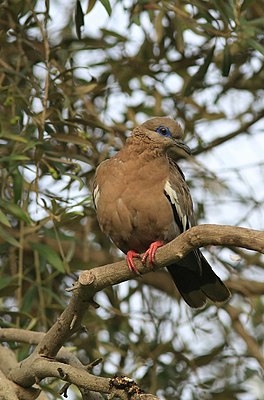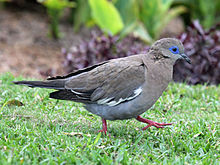Perute dove
| Perute dove | ||||||||||
|---|---|---|---|---|---|---|---|---|---|---|

Perute dove (Zenaida meloda), Lima |
||||||||||
| Systematics | ||||||||||
|
||||||||||
| Scientific name | ||||||||||
| Zenaida meloda | ||||||||||
| ( Tschudi , 1843) |
The perute dove ( Zenaida meloda ) is a species of pigeon birds. It occurs exclusively in South America and is not considered to be threatened in terms of its population. The mourning dove was scientifically described by Johann Jakob von Tschudi as early as 1843 . However, for a long time it was considered a subspecies of the white-winged pigeon . Only since the year 2000 has there been scientific consensus that the two species are not so closely related that it is justified to classify the Perute dove as a subspecies of the white-winged pigeon.
In German usage, the Peruvian pigeon has a similar-sounding name. However, this species belongs to the genus Columbina . The salvine pigeon from the American field pigeon is sometimes referred to as the perute pigeon .
Appearance
The perute dove reaches a body length of up to 33 centimeters. The plumage is grayish olive brown. The skull and neck are tinged with pink. Both behind the eye and below it there is a narrow, dark stripe. The most striking feature of the discrimination Mourning Dove and the eared dove is the white band at the outer edge of the wing. This characteristic is also found in the white-winged pigeon. However, the distribution area of the two pigeons does not overlap.
The wings of the hand are dark black-brown. The belly and rump are wine reddish. The tail is graduated. The outer tail feathers end with a wide, white band. The beak is dark gray. The iris is orange-red. The dark circles are featherless and blue-gray. The feet are reddish.
Distribution area and habitat
The distribution area of the Perute Dove extends from the south of Ecuador via Peru to the north of Chile. Only the coastal areas along the Pacific are settled. In Peru, the species is common and occurs both on agricultural land as well as in human settlement areas and open forests. The altitude distribution ranges from the lowlands to heights of 2,000 meters above sea level.
The Perute dove inhabits arid to semi-arid habitats. In the south of Ecuador it is also found in mangrove areas and arid shrub areas along the coast. The settlement area also includes isolated prosopis bushes in the Atacama Desert .
behavior
The perute dove is a resident bird. Longer flights are undertaken by individual populations to get to the feeding grounds. In Lima, Peruvian pigeons migrate in large numbers from the suburbs to agricultural areas to look for food. It is a ground-dwelling and not very shy species. The food spectrum includes seeds, small fruits and berries and, to a lesser extent, insects and their larvae. Peruvian pigeons breed all year round. However, the peak of reproductive activity is in the period June to September. The nest is built low in trees and, more rarely, on buildings and consists of a loose platform of branches. The clutch consists of two eggs that are incubated for 12 to 13 days. The young birds fledge after twelve to 16 days. Peruvian pigeons often raise a second brood as soon as the first one has flown out.
supporting documents
Individual evidence
literature
- David Gibbs, Eustace Barnes and John Cox: Pigeons and Doves - A Guide to the Pigeons and Doves of the World. Pica Press, Sussex 2001, ISBN 90-74345-26-3 .
- Kevin P. Johnson & Dale H. Clayton: A Molecular Phylogeny of the Dove Genus Zenaida: Mitochondrial and Nuclear DNA sequences. In: Condor . 102 (4), 2000, pp. 864-870 ( PDF ).
Web link
- Zenaida meloda inthe IUCN 2013 Red List of Threatened Species . Listed by: BirdLife International, 2012. Retrieved October 31, 2013.

